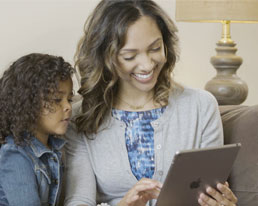The Gait Lab: gait and motion analysis
Dayton Children's is one of the few hospitals in the country that offers patients a gait and motion analysis laboratory. The Gait Lab's state-of-the-art computer technology can identify problems that are not always detectable in a typical clinical exam and offer children more specific treatment options for movement issues with better results.
what is gait and motion analysis?
Using computer technology, motion analysis captures movements, muscle activity and forces that the eye can’t see. Although people might have similar walking patterns, the way they move is very different. Gait and motion analysis helps to understand how muscles and joints work together. The results from gait and motion analysis help our providers recognize how orthopedic, neurological and muscular conditions limit movement that is critical to daily living.
After a gait and motion analysis exam, we review the reports and make a treatment recommendation for your child. Treatments could include surgery, physical therapy, medications or modifications to any orthotic, walker, crutches, or special brace or prosthetic they use.
who can benefit from gait and motion analysis?
Kids who have complex conditions and injuries are often recommended to have movement analysis. Your child might benefit from a gait assessment if they have:
• Cerebral palsy
• Spina bifida
• Arnold-Chiari formation
• Muscular dystrophies
• Orthopedic/musculoskeletal conditions that impact gait and functional movement
• Clubfoot
• Femoral/tibial torsion
• Toe walking
• Leg length discrepancy
who is on the Gait Lab team?
The lab’s multidisciplinary team consists of an orthopedic surgeon, physical therapist, and biomechanical engineer working together to gain a complete understanding of how a child moves and functions.
what to expect
Gait and motion analysis is done by a team of specialists in a gait lab that is equipped with advanced video, motion capture and other monitoring equipment. A typical visit lasts approximately two hours and involves several steps:
- video
First, your child walks across the room while being videotaped. This visual record helps providers understand walking difficulties and provides a reference point for measuring treatment outcomes.
- physical exam
A physical therapist assesses your child’s strength, range of motion, bony alignment, levels of spasticity and motor control. These measurements provide important information when analyzing the gait data in order to plan treatments and help measure the effectiveness of treatment.
- equipment and motion analysis
Before motion capture and muscle monitoring begin, a physical therapist applies small reflective balls and sensors to your child’s body. Special cameras track the movement of the reflectors as your child walks through the gait lab. They will record when muscles are active and at rest. Instruments in the floor measure the force produced by the muscles at the joints as your child walks.
- plantar pressure testing
Your child walks across a special mat that senses the pattern and distribution of pressure under the feet. This data helps to highlight patterns, forces, and pressures that cameras can’t capture.
- follow-up evaluation
After a period of time, your child might be asked to come back for follow-up testing. Repeated analyses can help determine whether your child has changed after treatment or with time.
preparing for your visit
what to bring
- Tight-fitting shorts such as compression shorts, girls should bring along tank tops.
- Braces and walking aids (such as crutches, walkers or canes), if applicable.
- Shoes used for walking with and without braces.
- Familiar toys or books (optional).
how do I make an appointment with the Gait Lab?
Patients need a physician referral to be seen in the Gait Lab. Call 937-641-3024 for questions on the Gait Lab and referral process.
Appointments are available without a physician referral.
The orthopedics department welcomes phone calls to 937-641-3010 during our normal business hours of 8:00 am to 5:00 pm Monday-Friday.
937-641-3010


